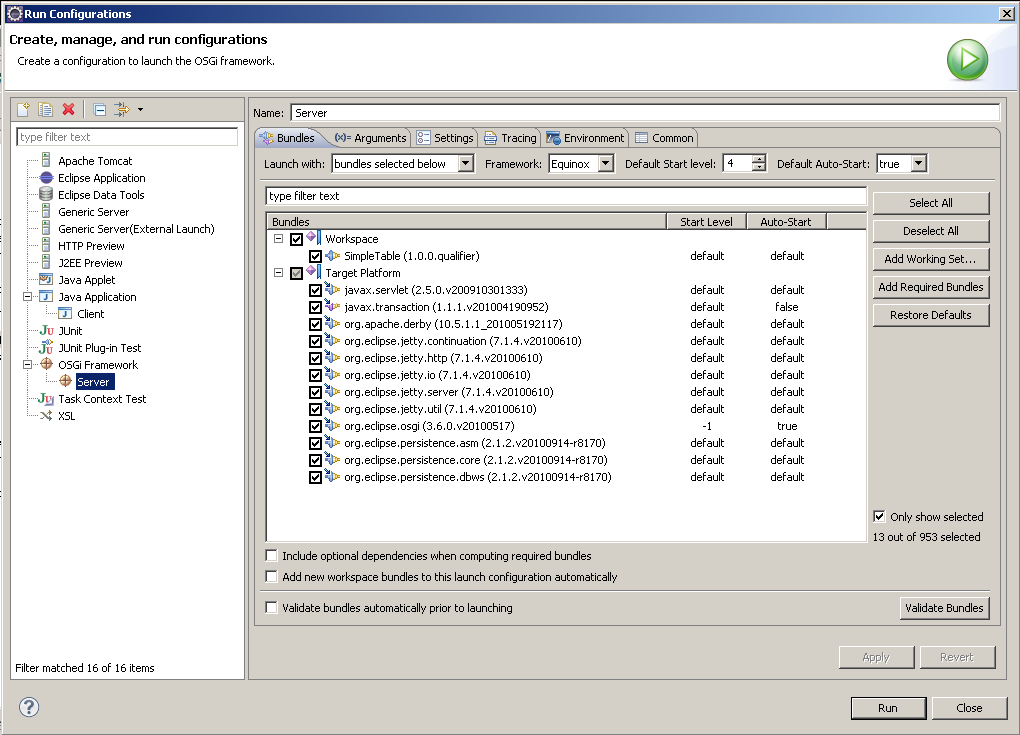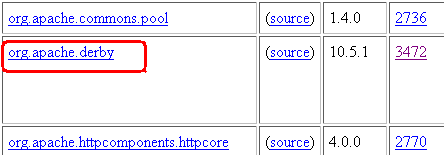Notice: This Wiki is now read only and edits are no longer possible. Please see: https://gitlab.eclipse.org/eclipsefdn/helpdesk/-/wikis/Wiki-shutdown-plan for the plan.
Difference between revisions of "EclipseLink/Examples/DBWS/AdvancedOSGi"
(→Running the DBWS Provider-Activator) |
|||
| Line 183: | Line 183: | ||
=== Running the DBWS Provider-Activator === | === Running the DBWS Provider-Activator === | ||
| − | In the Eclipse IDE, select the <code>MANIFEST.MF</code> and bring up the context menu for 'Run As' -> 'Run Configurations' -> 'OSGi Framework' to create a new launch configuration:<br/> | + | In the Eclipse IDE, select the <code>MANIFEST.MF</code> file and bring up the context menu for 'Run As' -> 'Run Configurations' -> 'OSGi Framework' to create a new launch configuration:<br/> |
[[Image:EclipseLink DBWS with OSGi NewLaunch.png]]<br/> | [[Image:EclipseLink DBWS with OSGi NewLaunch.png]]<br/> | ||
Revision as of 11:35, 12 August 2010
DBWS in an OSGi Environment
An Eclipselink DBWS service can be run in an OSGi environment using Javase 6's 'containerless' javax.xml.ws.Endpoint API.
Environment Setup
Download a version of the Eclipse IDE that includes the Plug-in Development Environment (PDE) (Eclipse IDE for Java EE Developers, Eclipse Classic 3.6.0 or
Eclipse for RCP and RAP Developers).
Install an OSGi-friendly JDBC driver - use Derby bundle:
- Download Apache Derby (org.apache.derby) bundle from Orbit.
- Place the org.apache.derby bundle into your $ECLIPSE_HOME/dropins folder.
- Install the EclipseLink and Jetty target Components:
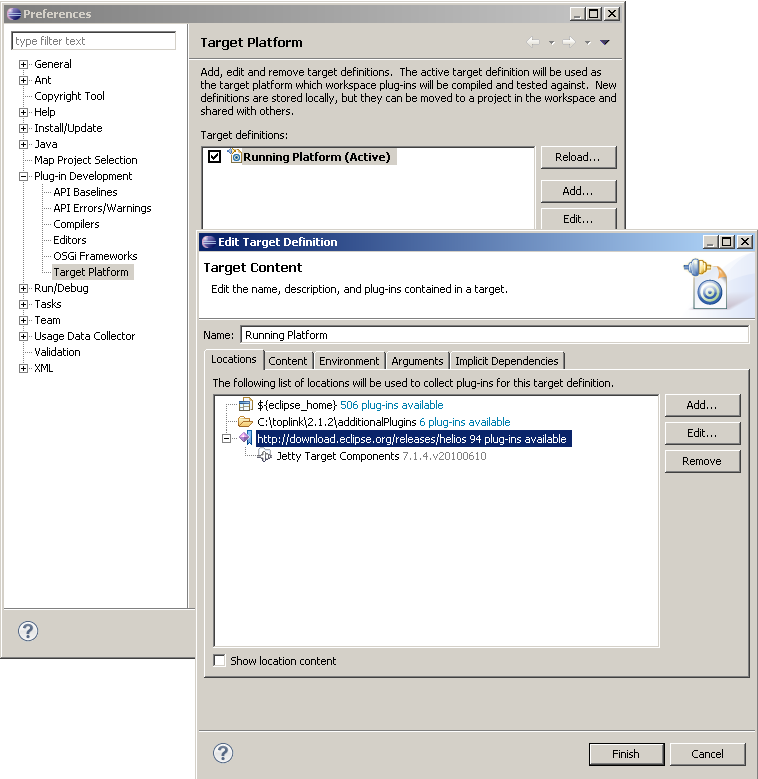

Accept the license and proceed through the prompts for re-starting Eclipse ...
{NB - later, a set of updated EclipseLink bundles will be required}
Under 'Preferences' -> 'Plug-in Development' -> 'Target Platform', reload the Running Platform (Active)
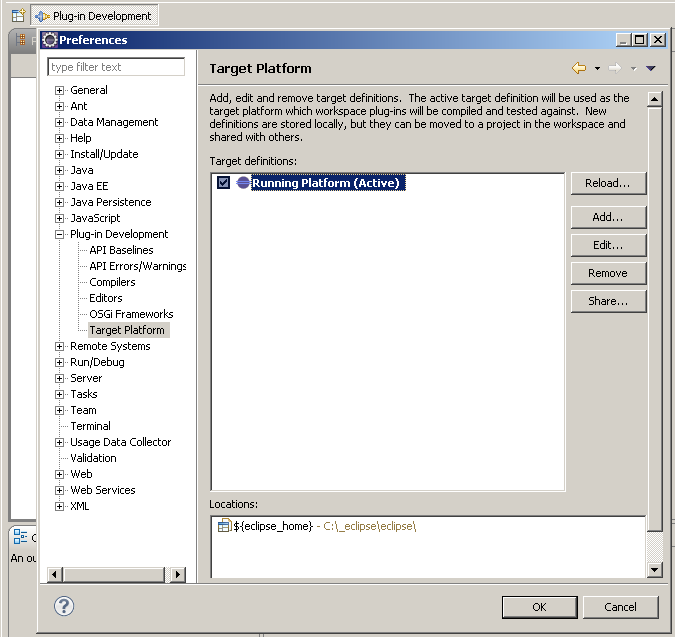
Create a new Plug-in project
From the 'Plug-in Development' Perspective, create a new Plug-in project SimpleTable:
{Note the choice of 'standard' for OSGi framework}
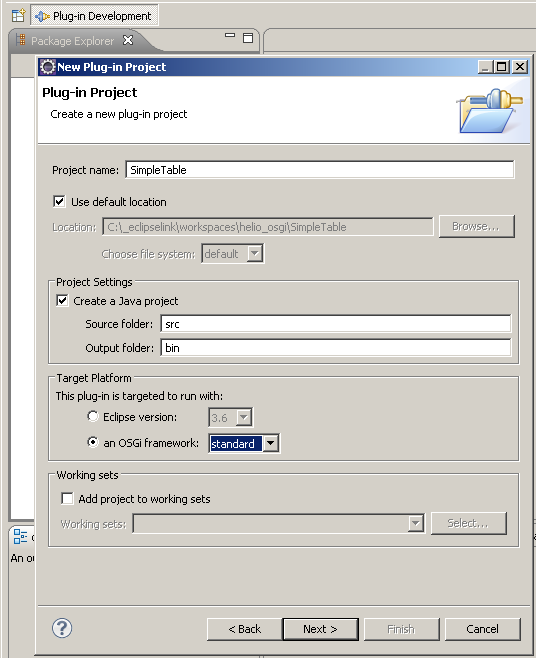
Proceed to the next panel of the wizard where the (OSGi bundle) Activator for SimpleTable is defined:
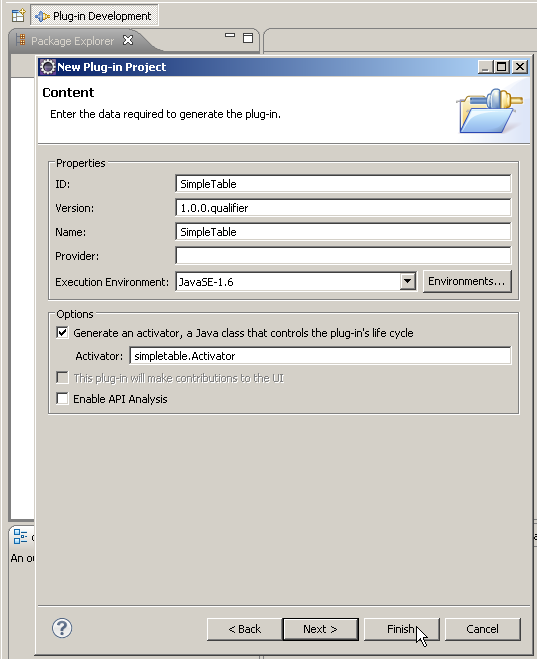
Click 'Finish' and open the generated Activator:
package simpletable; import org.osgi.framework.BundleActivator; import org.osgi.framework.BundleContext; public class Activator implements BundleActivator { private static BundleContext context; static BundleContext getContext() { return context; } /* * (non-Javadoc) * @see org.osgi.framework.BundleActivator#start(org.osgi.framework.BundleContext) */ public void start(BundleContext bundleContext) throws Exception { Activator.context = bundleContext; } /* * (non-Javadoc) * @see org.osgi.framework.BundleActivator#stop(org.osgi.framework.BundleContext) */ public void stop(BundleContext bundleContext) throws Exception { Activator.context = null; } }
Modifying Activator to implement javax.xml.ws.Provider
In order for our Activator to 'provide' Web service, we need to update the EclipseLink bundles. Builds after
2.1.1.v20100805-r7986 have EclipseLink DBWS packaged as a 'fragment' bundle that extends the core
org.eclipse.persistence bundle. Download the updated bundles and extract the following 6 bundles:
directory:
$ ls updatedBundles/ org.eclipse.persistence.asm.source_2.1.1.v20100805-r7986.jar org.eclipse.persistence.asm_2.1.1.v20100805-r7986.jar org.eclipse.persistence.core.source_2.1.1.v20100805-r7986.jar org.eclipse.persistence.core_2.1.1.v20100805-r7986.jar org.eclipse.persistence.dbws.source_2.1.1.v20100805-r7986.jar org.eclipse.persistence.dbws_2.1.1.v20100805-r7986.jar
Edit the Target Platform, adding the directory with the above bundles:
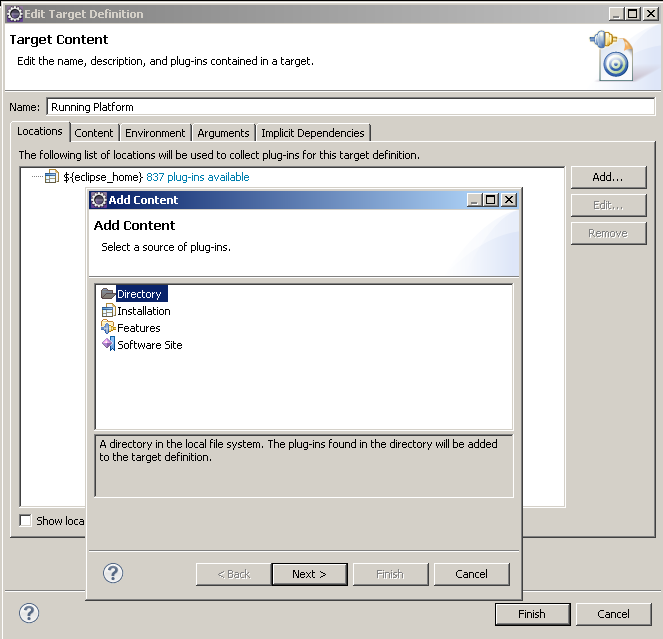
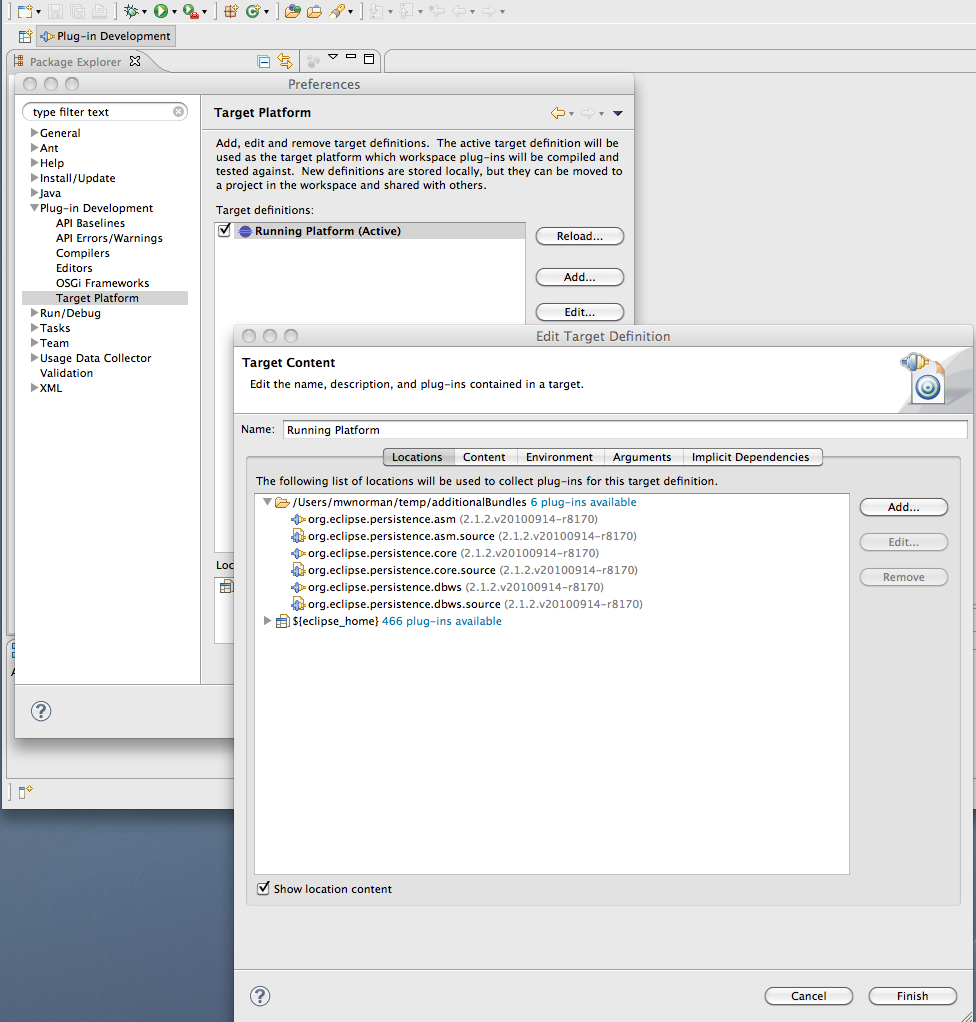
Change the Activator to extend org.eclipse.persistence.internal.dbws.ProviderHelper (NB - will show error):

In order to correct the error, the SimpleTable project needs to update its list of required bundles. Open the MANIFEST.MF file in the 'Plug-in Manifest Editor' and select the 'Dependencies' tab and add the following bundles:
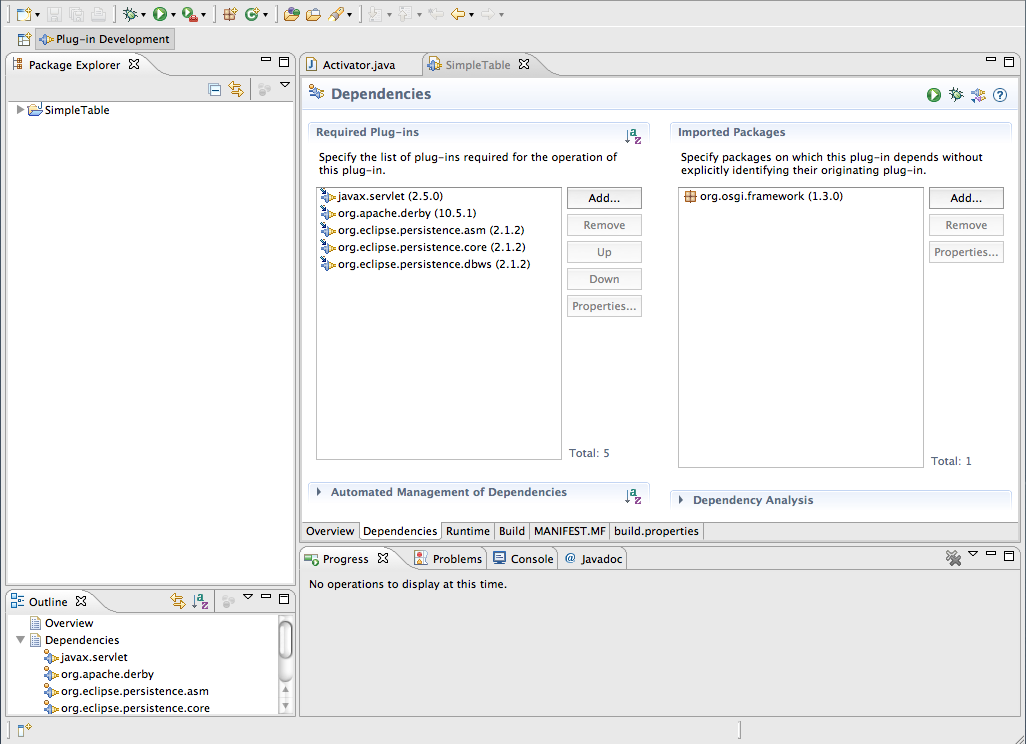
Note: you do not have to directly reference the DBWS bundle since its 'host' bundle org.eclipse.persistence.core is included in the list of 'Required Plug-ins'
The Activator needs to be annotated to support a (dynamic) Web services Endpoint:
public class Constants { //JAX-WS properties public static final String TEST_NAMESPACE = "urn:" + TEST_PROJECT; public static final String TEST_SERVICE = TEST_PROJECT + "Service"; public static final String TEST_SERVICE_NAMESPACE = "urn:" + TEST_SERVICE; public static final String TEST_PORT = TEST_SERVICE + "Port"; public static final String ENDPOINT_ADDRESS = "http://localhost:9999/" + TEST_PROJECT; } package simpletable; //java eXtension imports import javax.xml.namespace.QName; import javax.xml.soap.SOAPMessage; import javax.xml.ws.Endpoint; import javax.xml.ws.Provider; import javax.xml.ws.Service; import javax.xml.ws.WebServiceProvider; import javax.xml.ws.ServiceMode; import static javax.xml.ws.Service.Mode.MESSAGE; import static javax.xml.ws.soap.SOAPBinding.SOAP11HTTP_BINDING; //EclipseLink imports import org.eclipse.persistence.internal.dbws.ProviderHelper; import org.eclipse.persistence.sessions.Session; //OSGi/PDE imports import org.osgi.framework.BundleActivator; import org.osgi.framework.BundleContext; //test imports import static simpletable.Constants.ENDPOINT_ADDRESS; import static simpletable.Constants.TEST_PORT; import static simpletable.Constants.TEST_SERVICE_NAMESPACE; import static simpletable.Constants.TEST_SERVICE; @WebServiceProvider( targetNamespace = TEST_SERVICE_NAMESPACE, serviceName = TEST_SERVICE, portName = TEST_PORT ) @ServiceMode(MESSAGE) public class Activator extends ProviderHelper implements BundleActivator, Provider<SOAPMessage> { private static BundleContext context; private static Endpoint endpoint = null; private static QName portQName = null; private static Service testService = null; static BundleContext getContext() { return context; } /* * (non-Javadoc) * @see org.osgi.framework.BundleActivator#start(org.osgi.framework.BundleContext) */ public void start(BundleContext bundleContext) throws Exception { Activator.context = bundleContext; super.init(getClass().getClassLoader(), null, false); endpoint = Endpoint.create(this); endpoint.publish(ENDPOINT_ADDRESS); QName serviceQName = new QName(TEST_SERVICE_NAMESPACE, TEST_SERVICE); portQName = new QName(TEST_SERVICE_NAMESPACE, TEST_PORT); testService = Service.create(serviceQName); testService.addPort(portQName, SOAP11HTTP_BINDING, ENDPOINT_ADDRESS); System.out.println("Hello, " + testService.toString()); } /* * (non-Javadoc) * @see org.osgi.framework.BundleActivator#stop(org.osgi.framework.BundleContext) */ public void stop(BundleContext bundleContext) throws Exception { Activator.context = null; if (endpoint != null) { endpoint.stop(); } super.destroy(); System.out.println("Goodbye"); } }
Running the DBWS Provider-Activator
In the Eclipse IDE, select the MANIFEST.MF file and bring up the context menu for 'Run As' -> 'Run Configurations' -> 'OSGi Framework' to create a new launch configuration:
